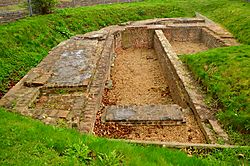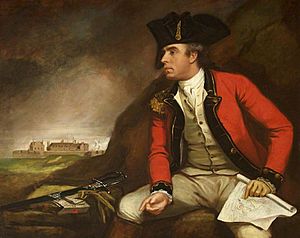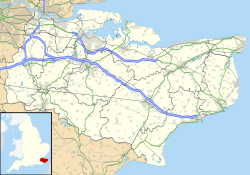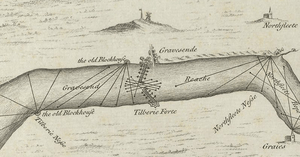Gravesend Blockhouse facts for kids
Quick facts for kids Gravesend Blockhouse |
|
|---|---|
| Gravesend, Kent | |

Foundations of Gravesend Blockhouse
|
|
| Coordinates | 51°26′41″N 0°22′22″E / 51.44463°N 0.37277°E |
| Type | Device Fort |
| Site information | |
| Condition | Foundations remain |
| Site history | |
| Materials | Brick and stone |
The Gravesend Blockhouse was a strong fort built a long time ago, in 1539. It was part of King Henry VIII's big plan to protect England from attacks by other European countries. This fort was built in Gravesend, Kent, right by the River Thames. This spot was very important because it controlled who could sail up the river towards London.
The blockhouse was ready for use by 1540. It was a two-storey building shaped like a letter 'D', made from brick and stone. It had a round part called a bastion that looked out over the river. There were also special platforms on either side for cannons. The Gravesend Blockhouse worked with Tilbury Fort on the other side of the river to guard the Thames.
The fort was repaired in 1588 when the Spanish Armada threatened to invade England. It was fixed again in 1667 after the Dutch navy sailed up the Thames. In 1778, experts suggested changes to the blockhouse. This led to new gun platforms and the building of a bigger fort nearby, called New Tavern Fort. By the 1830s, the government decided to use only the newer forts. The old blockhouse was taken down in 1844. Its remains were found during archaeological excavations in 1975 and 1976.
Contents
Protecting England: The 16th Century Fort
Why Build a Fort?
The Gravesend Blockhouse was built because of big arguments between England, France, and the Holy Roman Empire. This happened during the last years of King Henry VIII's rule. Before this, England usually let local lords and towns handle their own coastal defenses. The king didn't get too involved in building forts.
While France and the Empire were fighting each other, England didn't worry much about a full-scale invasion. There were some small forts, like simple blockhouses, along the south coast. But overall, England's defenses were not very strong.
In 1533, King Henry VIII made a big decision. He broke away from Pope Paul III because he wanted to end his marriage to Catherine of Aragon. Catherine was the aunt of Charles V, the Holy Roman Emperor. Charles V felt insulted by Henry's actions. Because of this, France and the Empire teamed up against Henry in 1538. The Pope even encouraged them to attack England. Suddenly, it looked like England would be invaded!
The King's Defence Plan
In 1539, King Henry VIII issued a special order called a "device". This order gave instructions for how to "defend the country in time of invasion." It also called for building new forts all along the English coastline.
As part of this plan, the River Thames got a strong network of forts. These included blockhouses at Gravesend, Milton, and Higham on the south side of the river. On the opposite bank, there were forts at Tilbury and East Tilbury. These forts were designed to support each other.
The forts were placed in very smart locations. London and the new royal shipyards at Deptford and Woolwich were at risk from attacks by sea. The Thames estuary was a major shipping route back then. About 80 percent of England's exports went through it.
The villages of Milton and Gravesend were very close, only about 500 meters apart. They were a key point for travel along the river. People used the "Long Ferry" to travel to London and the "Cross Ferry" to go across the river to Tilbury. This meant the riverbank was full of wharfs. This area was also the first place an invading army could easily land along the Thames. Before this point, the muddy riverbanks would have made landing very difficult.
Building the Blockhouse
The Gravesend Blockhouse was designed by important royal officials. James Nedeham was the Clerk of the King's Works, and Christopher Morice was the Master of Ordnance. Robert Lorde managed the money for the project. Lionel Martin, John Ganyn, and Mr Travers were the local supervisors.
The King bought the land for the fort from William Burston for £66. We don't know the exact cost of building the fort. However, in 1539, it was thought a blockhouse like this would cost £211. This included 150,000 bricks, plus stone, chalk, lime, wood, and the workers' wages. The building work was finished quickly. By 1540, the blockhouse was fully ready to defend the river.
The fort was about 28 meters long and 21 meters wide. It was two storeys tall and shaped like a 'D'. A round bastion stuck out into the Thames at the front. Another round bastion was on the side of the fort. Most of the building was made of brick, covered with ashlar stone. The outer walls were 2 meters thick.
Two walls ran along each side of the blockhouse, parallel to the river. These were part of the platforms for extra cannons. In 1600, the east platform was described as 100 feet long and 14 feet wide. The back of the blockhouse was overlooked by higher ground, which would have made it hard to defend.
The first commander of the fort was Captain James Crane. He had a team of ten men. This included his second-in-command, a gatekeeper, six gunners, and two soldiers. Over time, some gunners didn't work full-time at the fort. They lived and worked in the town. We don't know how many cannons the blockhouse had at first. But we do know that all five blockhouses along the Thames had 108 brass and iron cannons in total by 1540.
How the Fort Was Used
In 1553, orders were given to move the cannons from Gravesend Blockhouse to the Tower of London. But historians aren't sure if this actually happened.
In 1588, England faced a new threat of invasion, this time from Spain. The Spanish Armada sailed from A Coruña. A separate invasion force was getting ready in Flanders, threatening London. Robert Dudley, the Earl of Leicester, was put in charge of defending the Thames.
When Dudley checked the blockhouse, Gravesend was in bad shape. The gun platforms couldn't hold the weight of the cannons. The defenses needed more cannons and gunpowder. By then, the permanent team only had five gunners. One estimate said that 1000 feet of wood, 300 iron spikes, and 10 cartloads of smaller wood pieces were needed for repairs that summer.
Plans were made to block the river with a huge chain or boom. This chain would stretch between the blockhouse and Tilbury Fort on the other side. It cost £305 to build. More work was done on the defenses. This might have included building earth mounds and watch-houses. Fears of an invasion lasted for many years. In 1598, Charles Howard, the Lord High Admiral, worried that Gravesend Blockhouse wasn't strong enough to protect the Thames.
The Fort in the 17th Century
A survey in 1600 showed that 10 cannons were not working well. The gun platforms on either side of the fort were in poor condition. They needed a lot of wood for repairs. Not much money was spent on the fort under King James I or King Charles I. By 1630, the soldiers' pay was late, and the fort needed £1,248 worth of repairs.
In 1631, the blockhouse had several cannons. These included two brass demi-culverins and sakers. It also had iron cannons: one culverin, six demi-culverins, four sakers, and one minion. The brass cannons were needed for navy ships, so they were swapped for iron ones in 1635.
In 1642, the English Civil War began between King Charles I's supporters and Parliament. Parliament controlled Gravesend. They put a military governor in charge of both Gravesend Blockhouse and Tilbury. The fort was used to check ships entering London and to look for spies.
When King Charles II got his throne back in 1660, several royalists asked to be put in charge of the blockhouse. William Leonard eventually got the job. The defenses were repaired. The King may have even used the fort sometimes for banquets.
In June 1667, the Dutch fleet sailed up the Thames. But they didn't get close to Gravesend Blockhouse because of its cannons. The fort, led by Sir John Griffith, wasn't really ready for war. £400 was spent to improve the blockhouse. Cannons were sent from the Tower of London to help the local guns. Four groups of soldiers were sent to guard the site. The risk of attack ended when the Peace of Breda was signed that July. The blockhouse did not see any fighting.
Soon after the Dutch raids, Sir John was removed from his job. He was accused of demanding money from ships passing by the blockhouse. This complaint was made again in later years about other captains.
The Fort in the 18th and 19th Centuries

By the early 1700s, many buildings had grown up around the original blockhouse. It now had a pier, a dock, and two wharfs next to it. There was also a large house built by King James II, the Duke of York. About 20 cannons stretched out on either side along the river. The fort had a team of a sergeant, 20 soldiers, and a gunner from Tilbury Fort.
The blockhouse itself was no longer used for cannons. Instead, it became the magazine for the larger fort. It could store 2,500 barrels of gunpowder. After the Peace of Utrecht in 1713, the number of cannons was cut to ten. A survey in 1766 said that Gravesend was in good shape and had ten 9-pounder cannons.
People worried more about a French invasion. So, Sir Thomas Page checked the blockhouse in 1778. He decided that its cannons were too close together. He also noted they couldn't easily fire down-river. He suggested building a bigger fort further east along the Thames to fix this.
New Tavern Fort was built soon after. The eastern gun platform of Gravesend Blockhouse was redesigned and made longer as part of this work. Two groups of volunteer soldiers were formed in 1794 and 1797 to help defend the blockhouse. In 1805, it had 19 32-pounder cannons.
Concerns continued that the blockhouse's cannons couldn't fire downriver. By the 1830s, it was decided to put money into the New Tavern and Tilbury forts instead. The blockhouse stopped being used as a gunpowder magazine in 1834. It was briefly used as a government storage building. The gun platforms next to it were sold in 1835. The blockhouse building was then torn down in 1844.
Finding the Remains: The 20th and 21st Centuries
The place where the Gravesend Blockhouse once stood was dug up by archaeologists in 1975 and 1976. They found parts of the original building. The site is now in the grounds of the Clarendon Royal Hotel. It was made a scheduled monument in 1979, which means it is protected by UK law.





